I hope you enjoy this blog post. If you want Hello Bar to grow your leads, click here.
Author:
Michael Wicker
Published
May 21, 2024
I hope you enjoy this blog post. If you want Hello Bar to grow your leads, click here.
Author:
Michael Wicker
Published
May 21, 2024

SEO is one of the most sustainable ways to generate leads for your business. Through an optimized website and great content, you can organically attract leads to you, instead of trying to win them over with marketing.
That’s why SEO lead generation should be a top priority for you.
People use Google every day to search for things they want. They’re looking for products, services, information, and entertainment.
If those people can’t find your content through search engines, you’ll have to rely on far less reliable sources, such as social media. Sure, Facebook and Twitter can help drive traffic to your site, but organic search traffic can attract and convert consumers more effectively.
So how do you use SEO lead generation? And what does a good strategy look like? I’m going to delve deep into these questions and several others, so stick around.
SEO stands for search engine optimization. It’s been around for 20 years or longer, but it’s evolved considerably over the last few years.
It refers to the process of making your website pages as appealing as possible to search engines. I’m going to use Google as a stand-in for most of this article, but you’ll also generate traffic from other engines, such as Yahoo! and Bing.
When you optimize your website for SEO, you pay attention to several key factors:
These are the bare bones of a good SEO strategy, but they’ll help you improve your SEO lead generation.
You might have heard the terms “organic lead generation,” “SEO leads,” and “organic traffic.” They’re all related to the same goals.
Organic traffic refers to website visitors who arrive at your website — no matter the page — via the search engine results pages (SERPs).
Here, I’ve searched for Hello Bar. What you see below is the SERP that comes up.
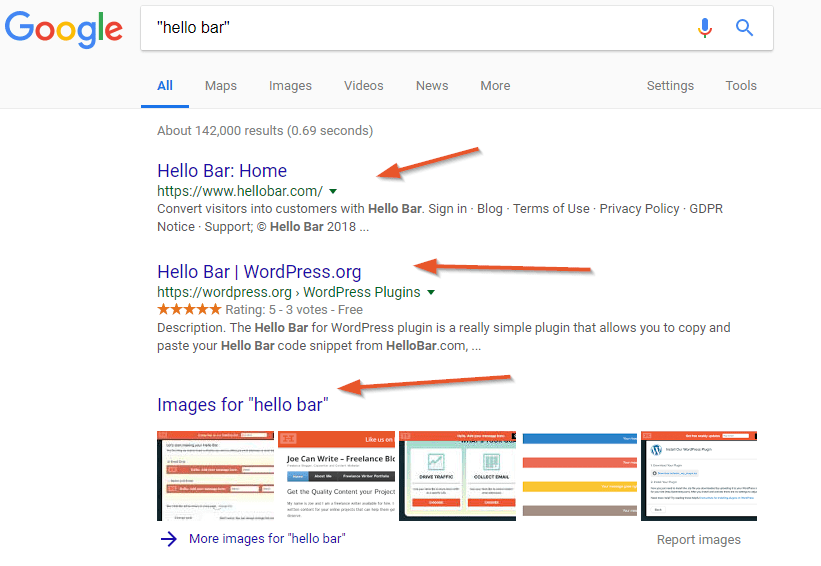
Each of the arrows I added points to a search engine result in the SERP. Two are for web pages, including the Hello Bar homepage, and one is for image results.
You want your website’s pages to appear as high in the SERPs as possible. That’s how you generate organic traffic.
But what about organic leads — also called SEO leads?
The goal of this strategy is to attract search engine traffic, and then convert visitors with your offer.
Let’s say that someone clicks on that first search result for Hello Bar. He or she sees the homepage:
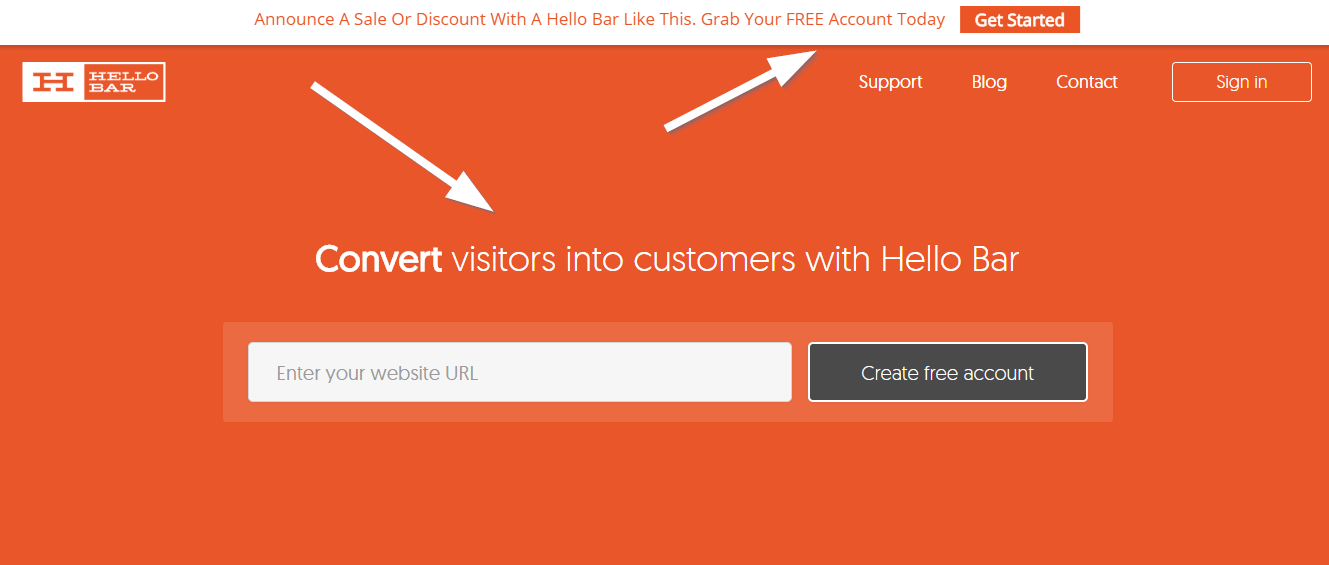
There are two primary CTAs here. They both send the user to the same page. There’s a top bar and a primary CTA above the fold.
If a website visitor who arrived via search engine clicked on either CTA and signed up for a free account, he or she would become a lead — specifically, an organic lead.
We know that organic leads cost less to acquire than paid leads. Content marketing and lead generation will bring in prospects and customers, but you don’t have to pay for them beyond setting up your site, creating content, and investing in helpful tools.
With paid ads, you can spend hundreds or even thousands of dollars. That doesn’t mean you shouldn’t test paid ads. However, if you’re strapped for cash, I recommend organic leads as your best source of potential revenue.

Think about how many Google searches you conduct every day. Every second, people around the world type 40,000 queries into the search engine. That’s huge.
If your website appears in the SERPs, you can take advantage of the visiting traffic for conversions. The process might look something like this:
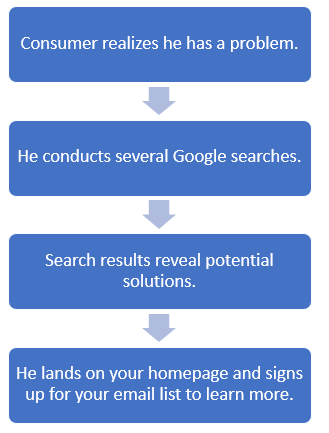
That last step represents a conversion, and it all came about because of a simple Google search. That’s the power of SEO lead generation.
Sometimes, the process looks a little more convoluted. Before converting, the consumer might check out your social media profiles, look for product reviews, or read some of your blog posts. Still, a late conversion is better than no conversion. That’s part of conversion rate optimization — getting people into your sales funnel.
If you’re not using SEO lead generation, you’re missing out on a huge opportunity. Anyone who finds you via search could become a customer, but only if you make the effort to convince them to convert.

First, I’m going to take you through the process of creating an SEO lead-generation strategy. These 13 steps will help you optimize each page of your website and better understand how to reach your target audience.
I’ll then share with you six tips for converting your visitors once they arrive via search. Let’s dig into the best SEO lead-generation strategies for your website.
Think about how you form relationships with people you meet in the offline world. You exchange names and pleasantries, and you try to find common ground.
That’s exactly how marketing works. If you don’t know what common ground you share with your audience, you’ll never connect. To get to that point, you need to know what makes your target customer tick.
Here are some questions you need to answer to clearly define your target audience.
Create a buyer persona that details as much as you know about a specific segment of your audience. What do they do for a living? What is their family situation? How much education do they have? What frustrations do they face on a daily basis?
Here’s a detailed buyer persona template you can use to create well-defined and unique buyer personas.
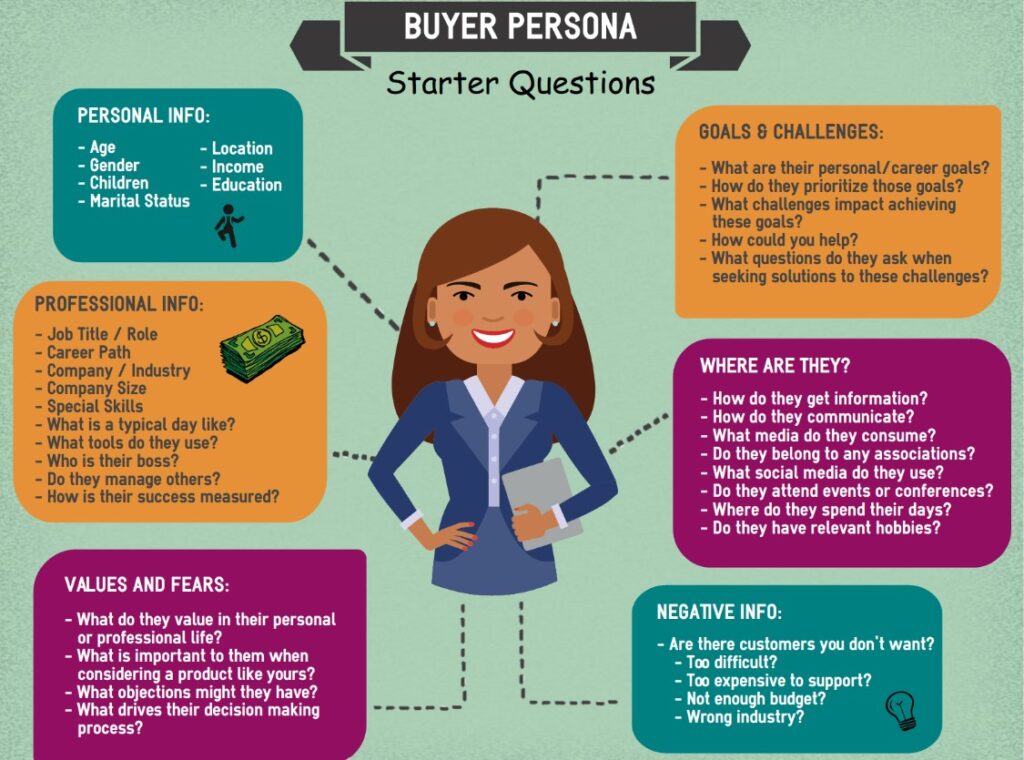
Image via Amy Wright
You can use this information to inspire content for your website.
For instance, if you know that your target audience struggles with losing weight, you could create a series of articles about how weight loss works, what fads are ineffective, and so on.
You also need to know where your target customer spends time online. If they use Google frequently, SEO lead generation should become a top priority.
You can always draw a direct line between your audience’s pain points and the eventual conversion.
Take Hello Bar, for instance. Our customers often struggle with lead generation. They’re not collecting enough email addresses to build their businesses efficiently. And that brings email marketing campaigns to a halt.
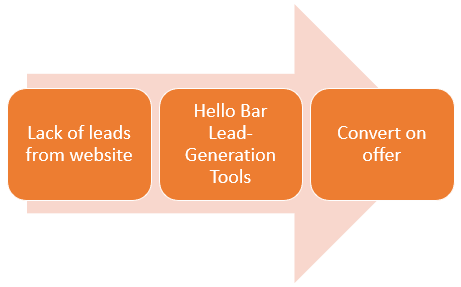
See what I mean? If the consumer didn’t suffer from a lack of leads for their business, they wouldn’t seek out Hello Bar (or tools that provide what Hello Bar does). That person wouldn’t be a member of our target audience.
Ask yourself the following questions to figure out your audience’s primary pain points:
Think of this as reverse-engineering pain points. To know how to target your audience, you need to know what your product or service can do for them. What problems does it resolve? How does it make life easier, more enjoyable, or more manageable?
If you look at Hello Bar’s website on a smartphone, you’ll notice that it serves the device well.
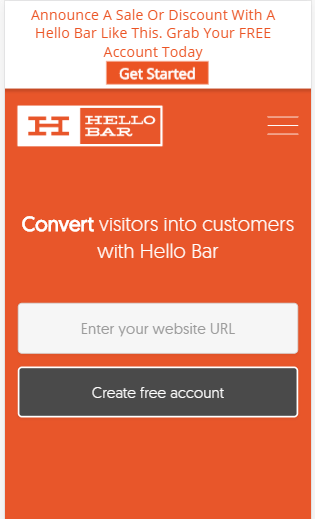
It has the same basic components as the desktop or laptop homepage, but it’s optimized for mobile devices.
Your website should do the same. Responsive design and Accelerated Mobile Pages (AMP) can help improve your SEO by allowing your website to load faster and by presenting readable, attractive pages to your audience.
Google has introduced a mobile-first index. This means that it’s rewarding websites that have mobile-friendly pages. You might see your site rankings drop down in the SERPs if you don’t embrace this new way of creating sites.
Google and other search engines rely on keywords to understand each web page in context. You don’t want to stuff keywords throughout your content — that’ll get you penalized — but you do want to include keywords in your copy.
Let’s say, for instance, that you run an ecommerce store that sells tennis equipment. You’ve decided to write an article about tennis exercises beginners can do to improve their game.
You’ll want a primary keyword, which should be included about once every 100 to 150 words. Then you’ll have secondary keywords — also called semantic keywords — that further help Google understand what you’re writing about. Pick two or three.
You can also use tertiary keywords, which are typically branded. For our tennis example, your keyword structure might look like this:
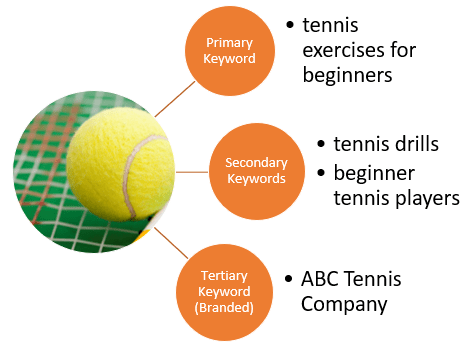
Competitive analysis is always helpful when it comes to SEO lead generation. If your competitors are doing a poor job, you can shoot above them in the SERPs.
After you’ve chosen a keyword, run a Google search and open the first 10 search results. Evaluate them for content as well as SEO. What could they have done better? What SEO attributes does the content lack?
Identify gaps you can fill to create better content on these topics, which has a high potential for ranking high on SERP.
Your page’s URL is one of the first signals Google sees when evaluating content. If your URL contains your main keyword, it’s more likely to rank.
If you visit the Hello Bar blog, you can click on any article to see its URL structure. I recently published an article with the focus keyword “social media strategy.” Check out the URL:
![]()
This lets Google know what the content is about and who might benefit from it.
You should also incorporate your primary keyword in your content’s headline or title. We’ll use the same Hello Bar example from above:
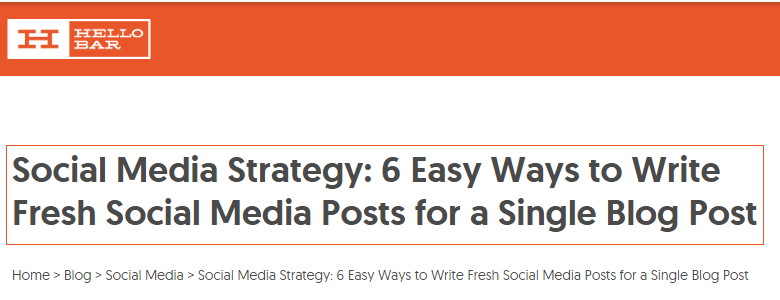
You’ll notice that the keyword — social media strategy — was placed at the beginning of the title. That’s deliberate. You want your keyword to appear as early in the title as possible.
This doesn’t just tell the search engines what your content is about, but also readers. If people spot certain keywords in a title, they’ll be sure that the content is exactly what they’re searching for and meets their intent.
Make sure you also add a meta title for all your blog posts and insert your main keywords there as well. This is great for SEO lead generation as it will get more readers to click on your results in the SERP and read your content.
If your title is too long, people won’t be able to view the entire thing in the SERPs. It’ll get cut off thanks to the tweaks Google has made to its listings.

See the ellipses at the end of that search engine result headline? It means the title was too long to display.
It’s also unfortunate because the most important information is likely at the end of the headline.
Don’t make this mistake and keep your titles short and catchy. Keeping the character length less than 60 characters is a rule of thumb you can follow.
If you don’t add a meta description, Google will do it for you — and you probably won’t like the results. As you can see from the SERP example above, the “Daily Mail” didn’t specify a meta description, so Google used a convoluted series of excerpts from the text.
Create an appealing meta description that will convince people to click. Google doesn’t take these descriptions into account as ranking signals, but they can influence whether consumers want to read your content.
Needless to say, add your main keyword in the meta description, for better SEO lead generation. Keep it toward the beginning of the meta description and not the end.
Also, make sure your meta description is not too long. Less than 160 characters is a simple rule you can follow.
Lastly, make your meta descriptions compelling enough to get readers to click on your SERP listing and check out your content. You can ask them a question or mention a challenge they relate to and then offer your content as the answer or solution.
If you read the article I referenced earlier, you’ll notice something important. The keyword — social media strategy — appears in the first paragraph of the copy.

This is important because it shows Google that your content is seriously devoted to the keyword in question.
You should also use your main keyword in the first H2, a few subheadings, and throughout the content. Keep a keyword density of 1% or more, but avoid keyword stuffing for effective SEO lead generation.
Remember those secondary and tertiary keywords we talked about earlier? Use them often in your article to help Google better understand the content.
You can find related keywords through Google Search Console and Ubersuggest. They’re search queries that are often related to the content in question.
Google’s SERPs can even help you out. Let’s say I search for “how to lose weight.” If I scroll past the first few organic results, I see a People Also Ask box:

These are related queries that you can work into your content as keywords or even as subheadings.
How does this help?
Semantically related keywords provide search engines with more contextual information about your content. This helps them index your content better and rank it for relevant search queries.
Content with related keywords has a higher chance of ranking than that with just one keyword, stuffed throughout. As you know, the higher you rank on SERP, the better it is for SEO lead generation.
People often search for information using questions:
If you target those questions in your content and give thorough, keyword-rich answers, you’ll rank higher and improve SEO lead generation.
One easy way to add question-type keywords is by adding an FAQ section to your blog posts. Answer commonly asked questions in this section and use it as an opportunity to add more related keywords to your content.
Domain authority is a number that ranks you against other websites and a specific algorithm. The higher your domain authority, the higher you’re likely to rank in the SERPs. You can check your site’s authority using a domain authority checker.
One key element of building domain authority is attracting inbound links from high-authority sites.
Some link-building techniques you can use are:
Practice these link-building techniques to improve SEO lead generation.
SEO and lead generation don’t improve overnight. This is a long game. That’s why you need to monitor the results of your efforts.
Use a free tool like Google Analytics. Track metrics like traffic, time on page, bounce rate, and conversions to see how you’re doing.

It should be clear by now that SEO lead generation is important. But how do you put it into action once you’ve attracted visitors?
Even if you’re not an SEO expert — many marketers and business owners aren’t — you can still master the simple steps and tweaks required to turn visitors into prospects. And, if you put into use these handy conversion strategies, you’ll be raking in leads before you know it.
A lead magnet does exactly what the name suggests. It attracts leads like a magnet by incentivizing them to sign up for your email list.
A lead magnet could be something as simple as a checklist or cheatsheet. My business partner uses a cheatsheet as a highly effective lead magnet over on NeilPatel.com.
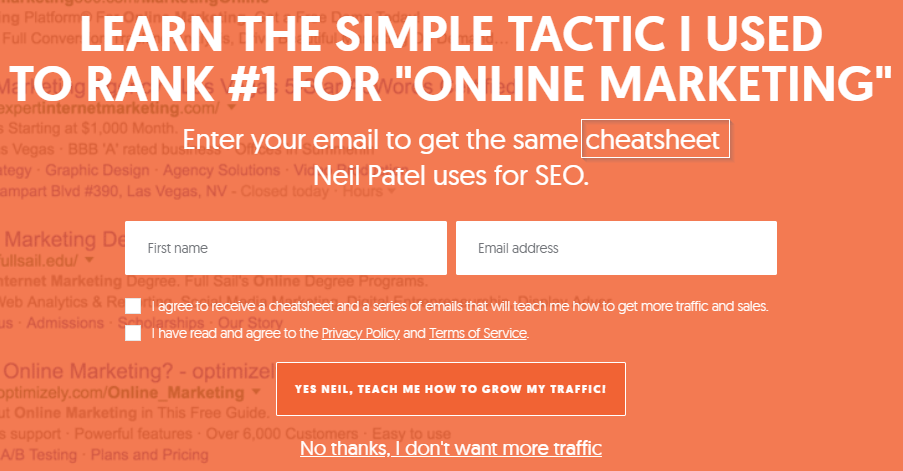
Announce your lead magnet in an appealing way and advertise it to your prospects. A top bar or page takeover exit popup can work well.

Then A/B test different headlines and CTAs to see what influences conversions more.
Gated content is similar to lead magnets, except instead of a deal or offer, you provide a comprehensive piece of content like an ebook or case study. It allows website visitors to gain access to expanded content by providing their email addresses.
Brian Dean uses this strategy in his content. He recently published an introduction to a case study about increasing traffic. He gives just enough to whet the readers’ appetite, then offers this button:
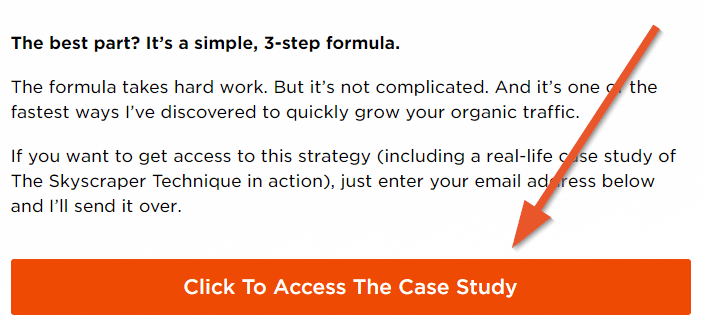
That’s a perfect example of using gated content for lead generation.
I’ve talked a lot about exit popups here on the blog, and for good reason. Exit popups can stop visitors from leaving your page after they arrive from a search result, but only when done well.
The best exit popups capture the reader’s attention, offer something of immense value, and engage the senses.

Here, I’ve used an evocative image in black and white so I don’t detract from the yellow color scheme. I’ve also communicated clear value and told the user exactly what to do.
If the visitor wants my free checklist, he or she will engage with the popup.
Social share buttons encourage people to share your content with minimal effort.

They just click the button and add any content they want to their post. Simple, right? That can bring even more traffic and encourage your visitors to follow you on social.
Plugins like AddThis allow you to use social share buttons for free on your own site.
CTAs encourage website visitors to engage with your content further. If they’re attractive enough, you’ll generate leads on the spot.
Think about the primary reason a visitor would be interested in your lead magnet. Lead with that in your headline.
I tweaked the exit popup I shared earlier to show another way of communicating value to your visitors.

Anyone who wants to feel less alone and get involved in a discussion will want to join. That’s a great way to use SEO lead generation because you’re converting organic website visitors into leads.
Here are some tips for using CTAs for lead generation:
Every page on your website should have a lead-capture form to collect information on site visitors. Whether it’s signing up for a newsletter or accessing gated content, short forms that collect user information are critical for lead generation.
Top bars are excellent for including signup forms on all website pages. You never have to worry if you missed one.
![]()
You can collect emails from people who visit your site no matter the time of day. As long as your lead capture forms inspire interest, you’ll persuade your audience.
Make sure your forms are not unnecessarily lengthy and become more a hindrance than a helpful tool for lead generation. Keep the number of form fields short and make it easy for site visitors to provide their details and take the next steps.
1. Is SEO good for lead generation?
Yes, search engine optimization is an effective way to generate leads for your business using your website content. With the right SEO tactics, you can create a steady stream of organic traffic and leads for years to come.
By creating relevant website content and optimizing your web pages, you can start a lead-generation engine that works on autopilot.
2. Why should I use SEO for lead generation?
SEO is one of the most sustainable and organic ways of generating leads for a business. It is not cost-intensive and only requires consistent effort to keep generating leads for your business in the long term.
If you’re looking for budget-friendly lead-generation tactics, then SEO should be your top choice.
3. Is SEO still relevant in 2024?
Absolutely! Search engine algorithms may have changed dramatically over the years, but keeping up with them and ensuring your website ranks high on SERP will always be important.
SEO is not some niche marketing tactic that has had its years of success and is now forgotten. It’s not just relevant, but more important now than ever before as it helps your website stand out from the numerous others in your niche.
Without SEO people searching for products, services, or content online won’t be able to find your website and engage with it. Given that site traffic is one of the main sources of business leads in today’s digital world, it’s vital for business success.
4. Which are the best SEO lead generation techniques?
Though there are numerous SEO lead-generation tactics you can use, here are some of our top picks:
5. Will SEO exist in 5 years?
Without a doubt! SEO was, is, and will remain relevant for any website that wants to rank high on SERP and get organic traffic. It is an evergreen lead generation and marketing tactic, so don’t hesitate to invest heavily in it.

Using SEO lead generation might not seem like the best strategy, but it’s worked for me over and over. Content marketing brings in organic (free!) prospects who will convert based on the value with which you provide them.
In other words, if you understand your audience and what they’re looking for, you can provide the solution and generate a lead.
It’s that simple.
Follow the strategies outlined above to skyrocket organic leads and use SEO lead generation. You won’t be disappointed. In the process, you’ll also build credibility and begin amassing an audience of fans.
Do you use SEO lead generation? Share your experience in the comments.